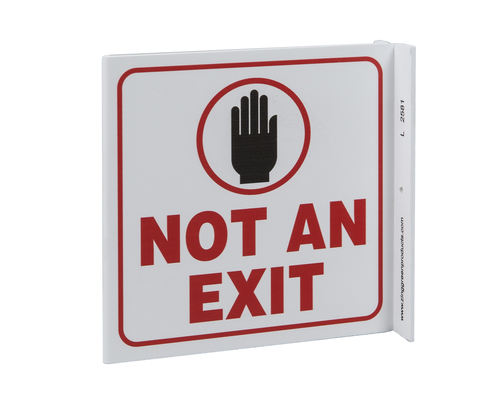Exit Routes: How be Safe and Compliant
Aug 2nd 2017
Exit routes are critical to workplace safety. Compliant exits can save lives and prevent serious injury during emergency situations. OSHA standard 1910.36 sets forth requirements for constructing and maintaining exit routes. This guide will help you prepare your workplace for safe and compliant exits.

OSHA defines the exit route as a continuous and unobstructed path of exit travel from any point within a workplace to a place of safety. There are three main components of an exit route: the exit access, the exit, and the exit discharge.
- Exit Access: the part of the exit route that leads to an exit.
- Exit: portion an exit route that is generally separated from other areas to provide a protected way of travel to the exit discharge.
- Exit Discharge: portion of the exit route which leads directly outside, or to a refuge area with access to the outside.
Workplaces must have at least two functional exits. This is fundamentally important to a building’s safety; multiple exits ensure that there is still a viable escape path if one exit is blocked by smoke or fire. Some buildings might require more than two exits. From OSHA: More than two exits are required, however, if the number of employees, size of the building, or arrangement of the workplace will not allow employees to evacuate safely.
GENERAL EXIT ROUTE REQUIREMENTS
- Exit routes must be permanent features of a floor-plan.
- No explosive or highly flammable materials can be on the exit path.
- The exit path must be kept unobstructed from all equipment or clutter that might prevent occupants from moving towards exits.
- The egress route must be at least 7 feet, 6 inches high, and be able to support the maximum number of occupants allowed in the relevant floorplan. The exit access must be 28 inches wide at all points.
- Exit doors must be unlocked from the inside.
- Doors that connect to the exit route must have side hinges, and open in the direction of exit travel.
- Exit routes must support the maximum occupant load for each floor served.

LIGHTING AND SIGNAGE
Employees with normal vision must be able to clearly see exits. Special attention should be given to lighting installations near exits, so that these locations are emphasized. Emergency lighting must also be in place, in case of smoke or power outages. Emergency glow strips, which adhere to the floor along an exit pathway, are a good way to make sure egress paths are easy to see and follow.
Every exit must be marked by a sign reading, “EXIT.” When possible, signs should be standardized throughout a facility by color scheme and dimensions. The word “EXIT” must be at least 6 inches high and ¾ of an inch wide. The signs must also be clearly illuminated. There are two options: signs can either be illuminated by an external light source or can be self-luminescent. If signs are lit by an external light source, the light source must be reliable and illuminate the surface of the sign to a value of at least five foot-candles. Self-luminescent signs must produce at least 0.6 footlamberts of illumination. Because they do not require an electrical charge, self-luminescent signs can be a convenient choice for many workplaces.
If the direction of an exit path is not readily apparent, signs indicating the direction of an exit path are required. These signs have the word “EXIT” with an arrow pointing in the direction of the exit route. The line of sight to an exit sign must be clear at all times.
To prevent potential confusion during an emergency exit situation, doors or passages along the exit route that are not exits must clearly be marked “NOT AN EXIT,” or designated according to its function (for instance, “CLOSET” or “BATHROOM”).
TYPES OF EXIT SIGNAGE
Exit signs are a critical aspect of emergency safety compliance, so it is important to pick the signs that best suit the needs of your workplace. Compliant signs are readily available, but is a good idea to consider the material and format of the signs, and the environment they will be used in. Here is a brief overview of exit sign types:
Plastic or aluminum: These signs provide durable, long-term solutions to exit signage. These signs are suitable for indoor and outdoor applications and can be expected to provide high-performance safety for 5-10 years.
Adhesive: These signs adhere directly to doors or other hard surfaces and are recommended for indoor use. The life span of adhesive signs is 2-5 years.
Projecting: Projecting signs provide the highest visibility. Usually of plastic construction, these signs project outward from a wall, providing 180-degrees of visibility. Because the signs can be seen clearly from a variety of locations and angles, projecting signs are especially popular for indicating exits or other important emergency locations.

EXIT CONSTRUCTION
Exits must be constructed to perform during critical fire emergencies. To ensure proper fire safety OSHA sets forth the following requirements:
- Exits must be separated by fire-resistant materials.
- A one-hour fire-resistance rating is required if the exit connects 3 stories or less; if an exit connects more than three stories, a two-hour fire-resistance rating is required.
- All exit openings must be protected by a functional, self-closing fire door.
To prevent potential confusion, exits can only have openings that lead directly to the exit discharge.
EXIT PROCEDURES
If a workplace has more than 10 employees, a written exit safety procedure is required. Procedures must be kept at the workplace, and be available for employees to review. If less than 10 workers are employed, fire safety procedures can be communicated orally. Although oral plans are compliant in some cases, written procedures are recommended, even if a workplace has less than 10 employees. Written procedures provide an objective, reviewable reference point for fire safety, and encourage safe conduct.
An Emergency Action Plan (EAP) is not expressly required, but OSHA recommends developing an EAP for exit routes. The EAP should contain:
- Procedures for reporting fires and other emergencies
- Procedures for evacuation
- Procedures to account for all employees after evacuation
- Procedures for employees performing rescue or medical duties
- A functional alarm system for fires and other emergencies
- Procedures for employees who stay behind during emergencies to continue critical plant operations
The details of each EAP will depend in part upon the specific layout of each workplace, and the specific roles of each workforce.

